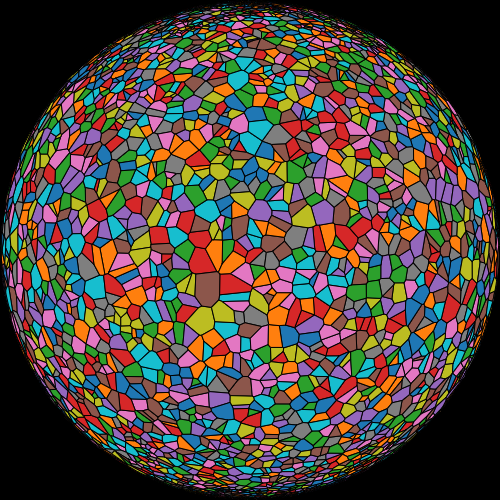d3_geo_voronoi_rs
| Crates.io | d3_geo_voronoi_rs |
| lib.rs | d3_geo_voronoi_rs |
| version | 0.10.7 |
| created_at | 2022-12-31 18:11:27.738388+00 |
| updated_at | 2025-07-24 15:00:59.872878+00 |
| description | A port into rustlang of the javascript library d3-geo-voronoi |
| homepage | |
| repository | https://github.com/martinfrances107/rust_d3_geo_voronoi.git |
| max_upload_size | |
| id | 748516 |
| size | 98,158 |
documentation
README
d3_geo_voronoi_rs
rust 2021 edition.
Given a set of objects in spherical coordinates, it computes their Delaunay triangulation and its dual, the Voronoi diagram.
This is a port of the d3-geo-voronoi library into a RUST library.
It is part of a collection of d3 modules ported to rust.
- d3_geo_rs
- d3_delaunay_rs
- d3_geo_voronoi_rs
As a example the library can be used to compute the following delaunay mesh.

( computed from 6,000 points on a sphere selected at random )
Currently we have 84% test coverage ( as reported by cargo tarpaulin -o Html )
Performance Profiling
Demo Page
The original javascript library has a benchmark in the form of web page which records the number of frames displayed per second. For comparison the benchmark has been ported.
- javascript - d3-geo_voronoi/src/benchmark/sphereCanvas.html
- rust - rust_d3_geo_voronoi/benchmark.
Measuring the performance of a library is complicated, as different applications employing the library may see different results. Desktop and mobile performance may differ.
There are traditionally two way of measuring increases in performance :-
A) Speed: By asking how long it takes to perform a certain computation?
B) Throughput: By asking how much more work can I perform in a given time?
A and B are ideally linearly related, but often high throughput requires more memory which may increase page swapping. Javascript uses garbage collection, rust does not. In garbage collected environments, the dynamics of a collectors behaviors may cause the figures reported by A and B to diverge.
Here are the results for the benchmark :-
A) When I tune the benchmark for 60ps, I find the javascript can render 600 points in 16ms. The rust version performs the same workload in 8.165ms. ( a factor 1.95 speedup).
B) When I increase the number of points given to the RUST version to render, I find I can render 1220 in 16ms. An increase of just under 2.
I am currently looking to add more benchmarks, a diverse collection of example application code, will give greater confidence in what to expect.
Profile Target
This workspace contain a binary "profile_target" which outputs the result of a computation similar to that of the demo_page. Before API finalization - I am currently using cargo flame-graph to identify any obvious optimizations.
from rust_d3_geo_voronoi
cargo install flamegraph
cargo flamegraph -- profile_target
Further Development
Considering migration 0.9.0 to 0.10.0. Many of the non idiomatic "new" methods have been replaced with a TryFrom implementation. For more details see the CHANGELOG.md
Currently the demo works only then f64 is used as the floating point type. [For f32 the cell integrity is broken as some of the cell appear to take-up the whole sphere.] To be ported:-
contour.js and geo-contour-test.js
Currently there is a failing test suite geo_voronoi_test.rs "geoVoronoi.hull does not break on difficult polygons"
Instructions for building the benchmark
I'm using wasm pack to package the following packages into a single wasm file. rust_d3_geo, rust_d3_delaunay.
The application displays a delaunay mesh of a large number of cells onto a sphere.
To build and start the web server:-
cd benchmark\www
npm install
npm run start
The last command automatically starts your web browser.
For benchmarking, to obtain best performance
cd benchmark\www
npm run build
npm run serve

